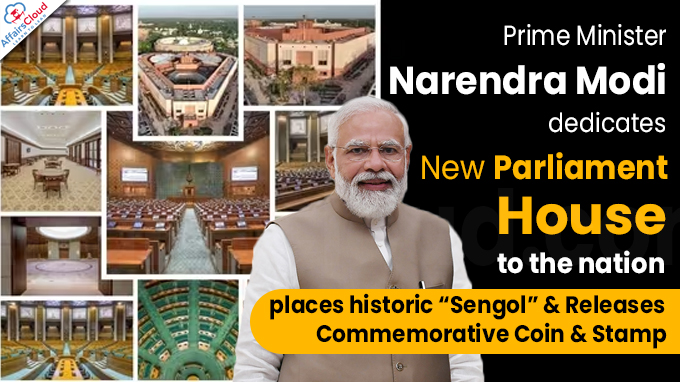 On May 28, 2023, Prime Minister Narendra Modi inaugurate the new building of Parliament House and dedicated it to the nation and installed the Sengol with Nandi at the top facing East-West direction in the new Parliament House.
On May 28, 2023, Prime Minister Narendra Modi inaugurate the new building of Parliament House and dedicated it to the nation and installed the Sengol with Nandi at the top facing East-West direction in the new Parliament House.
- PM stated the Parliament House as a witness to the development of Aatmnirbhar Bharat and the realization of a Viksit Bharat.
- PM Narendra Modi placed the historic sceptre ‘Sengol’ near the Lok Sabha Speaker’s chair in the newly built Parliament building. PM decided to adopt it as a national symbol of the Amrit Kaal.
- PM unveiled a commemorative stamp and a special Rs.75 coin during the inauguration of the new Parliament building.
Features of New Parliament Building:
i.The new parliament building includes the Lok Sabha, Rajya Sabha, Central Lounge, Central Hall for joint session, Constitutional hall, open courtyard and Offices.
- The new building is 4- storey triangular shaped and it is a part of a 20,000-crore central vista project built by TATA Group.
ii.Seating Capcity:
- The new Lok Sabha has a seating capacity of 888 members, almost thrice the number compared to the current chamber of 552 seats.
- The new Rajya Sabha complex have a seating capacity of 384 members compared to 245 seats of the current chamber.
iii.The Parliament premises have the national tree Banyan. The interiors of Lok Sabha are themed on the national bird peacock and Rajya Sabha on the national flower lotus.
iv.The building features the Ashoka Chakra on the exterior and inside the Lok Sabha and the Rajya Sabha chambers.
v.The new Parliament Building is a platinum-rated green building which aims to showcase India’s commitment towards sustainable development.
vi.It is also equipped with the latest technology and the halls are also sunlit. The building is also accessible by physically challenged people.
Additional info:
i.60,000 shramiks (worker) were given employment during the construction of the Parliament and a new gallery has been put up in the house highlighting their contributions.
- It is the first time that the contributions of Shramiks have been immortalized in the new Parliament.
ii.PM stated the new Parliament Building as a reflection of the aspirations and dreams of 140 crore Indians. He also stated the new building as an example of the coexistence of ancient and modern.
Present Parliament House:
India’s present Parliament House is a colonial-era building, Originally called the Council House, was designed by British architects Sir Edwin Lutyens and Herbert Baker, and it took six years to construct (1921-1927).
After the new Parliament House becomes operational the old parliament building will be converted into a ‘Museum of Democracy’.
Key Highlights of Sengol:
i.The name of the historical sceptre, ‘Sengol’ was derived from the Tamil word ‘semmai,’ meaning ‘righteousness/full of wealth’.
- Note – Sceptre is the Symbolic ornamental staff or wand held in the hand by a ruling monarch.
ii.Features:
- The sceptre Sengol,which is Constructed by Vummidi Ethirajulu and Vummidi Sudhakar, is made of gold and silver and is decorated with many precious stones.
- The sceptre measures 5 feet in length and carries a golden orb at the top. The orb has a carving of Nandi, the bull (that is precious to Lord Shiva) symbolising justice.
iii.Background:
- In the ancient South Indian kingdom, the great Chola empire, the Sengol holds great significance and it was seen as a symbol of power, authority, the path of service duty and nation.
- It was claimed that Thiruvavaduthurai Adheenam,a Saivite mutt based in the town of Thiruvaduthurai in Mayiladuthurai District, Tamil Nadu gifted the ‘Sengol’ to Jawaharlal Nehru in August 14, 1947 during India’s Independence.
iv.Now, the head priest of Madurai Adheenam (mutt) presented the same sceptre ‘Sengol’ to PM Narendra Modi. PM stated the Sengol as the sacred symbol of the transfer of power.
- Note – In Tamil, Adheenam is the oldest Saivite adheenam (also known as a matha or mutt), a form of Hindu monastery, in South India.
v.The ‘Sengol’, which was Previously housed in the Nehru Gallery of the Allahabad Museum ( Prayagraj, Uttar Pradesh), has now been transported to Delhi and installed in the newly constructed Parliament building.
vi.Significant Reference:
- The Tamil literary work ‘Thirukkural’ devotes an entire chapter to the importance of the ‘Sengol’, referred to as “sengonmai”, which highlights the significance accorded to the sceptre in Tamil culture.
- The Tamil epic ‘Silapathikaram’ also mentions the symbolic value of the ‘Sengol’.
Features of the Rs 75 Coin:

i.The weight of the coin would be around 34.65-35.35 grams. and it will bear the inscription of the Parliament complex and have the image of the new Parliament building.
- The year ‘2023’ will be engraved beneath the picture of the Parliament building.
- The parliament complex will be depicted on the coin’s reverse. The words ‘Sansad Sankul’ will be written in the Devanagari script on the upper peripheral, and on the lower periphery, “Parliament Complex” will be written in English.
ii.The coin is made from a four-part alloy, comprising 50% silver, 40% copper, 5% nickel and 5% zinc.
iii.The coin will be Circular in shape with a diameter of 44 mm and have 200 serrations along its edges.
iv.The Lion Capital of the Ashoka Pillar and the phrase ‘Satyamev Jayate’ will appear on one side of the coin.
v.‘Bharat’ and ‘India’ will be written in English (left) and Devanagari script (Right), respectively.
vi.The rupee symbol and the denomination value of 75 will be written on the coin beneath the Lion Capital. The value of 75 in international numerals will also be written below.





